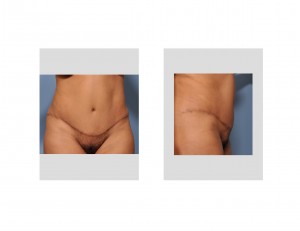Background: A tummy tuck is the most successful body contouring operation in plastic surgery that we know. Its dramatic removal of excess skin and fat, and vertical rectus muscle tightening, produces an outcome that patient’s can not otherwise achieve on their own. While there is a resultant scar, that is a worthwhile trade-off in the properly selected patient.
Liposuction is, more times than not, a part of a tummy tuck (abdominoplasty) procedure. It is integral for most patients to treat the flanks or the muffin top areas that are otherwise out of the zone of skin and fat excision. The sides of the tummy tuck into the back are almost always treated by liposuction to give more of a 270 degree waistline result rather than just a 180 degree improvement. There are just a small number of patients who get just a tummy tuck alone.
But not all areas of the abdomen can be treated with liposuction at the same time as a tummy tuck. The upper abdominal area and its sides (the upper skin flap of the tummy tuck) is usually not treated due to potential concerns about disrupting the blood supply and causing wound healing problems at the incision. While undermining and pulling down the upper abdominal skin flap does thin out its thickness (like stretching out an accordion), it may still leave some patients with fullness above the new belly button after their tummy tuck.




Case Highlights:
1) As effective as a tummy tuck is at reshaping the abdominal area, the thickness of fat of the redraped skin is not usually thinned out. Optimal abdominal and waistline reshaping for some patients may require secondary liposuction.
2) Liposuction after a tummy tuck can be done as early as 6 months after a tummy tuck. Complete healing of the tummy tuck is necessary before inducing the tissue trauma of liposuction.
3) Secondary liposuction can maximize the effects of a previous tummy tuck and is much easier procedure to undergo and recover afterwards.
Dr. Barry Eppley
Indianapolis, Indiana


